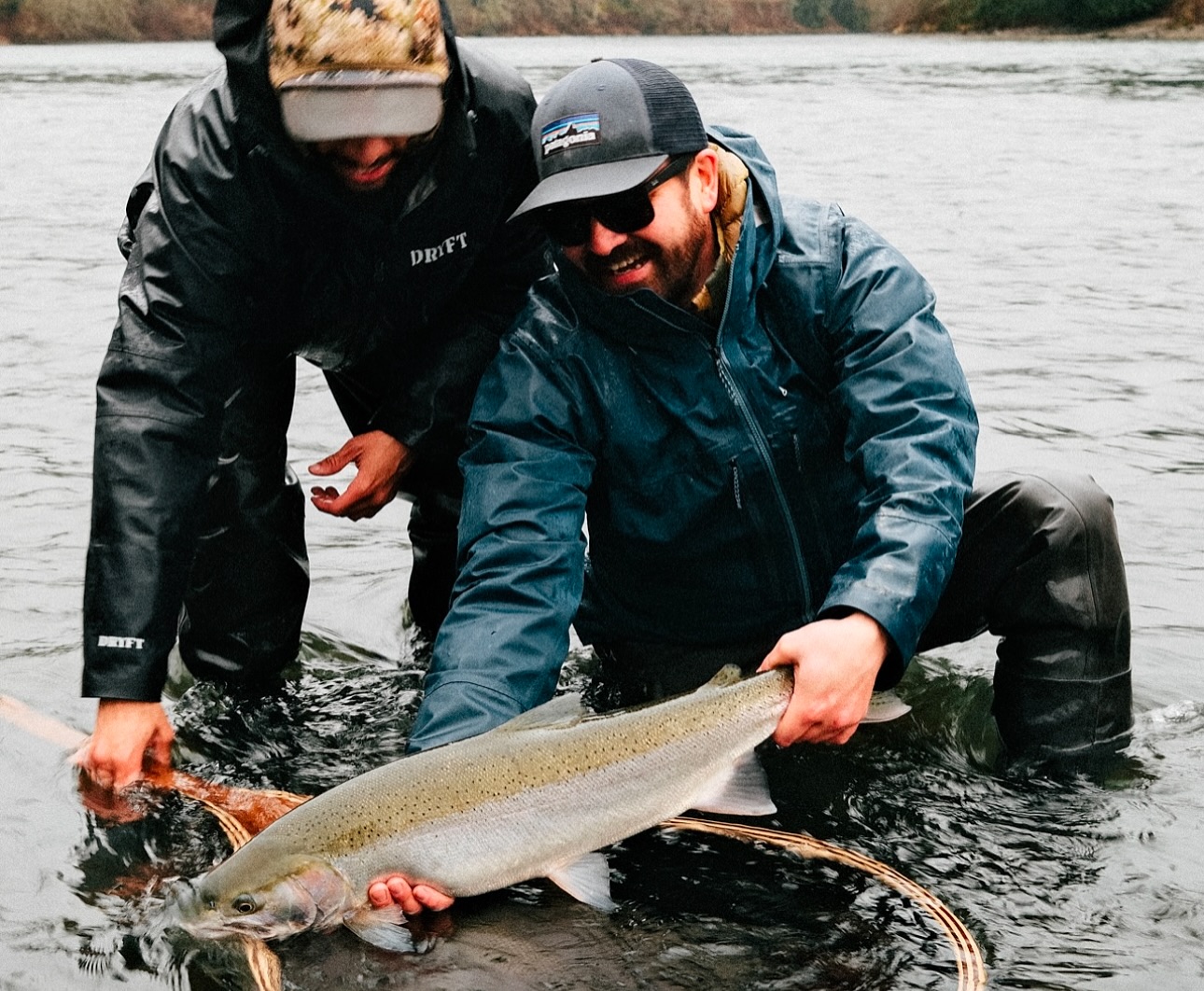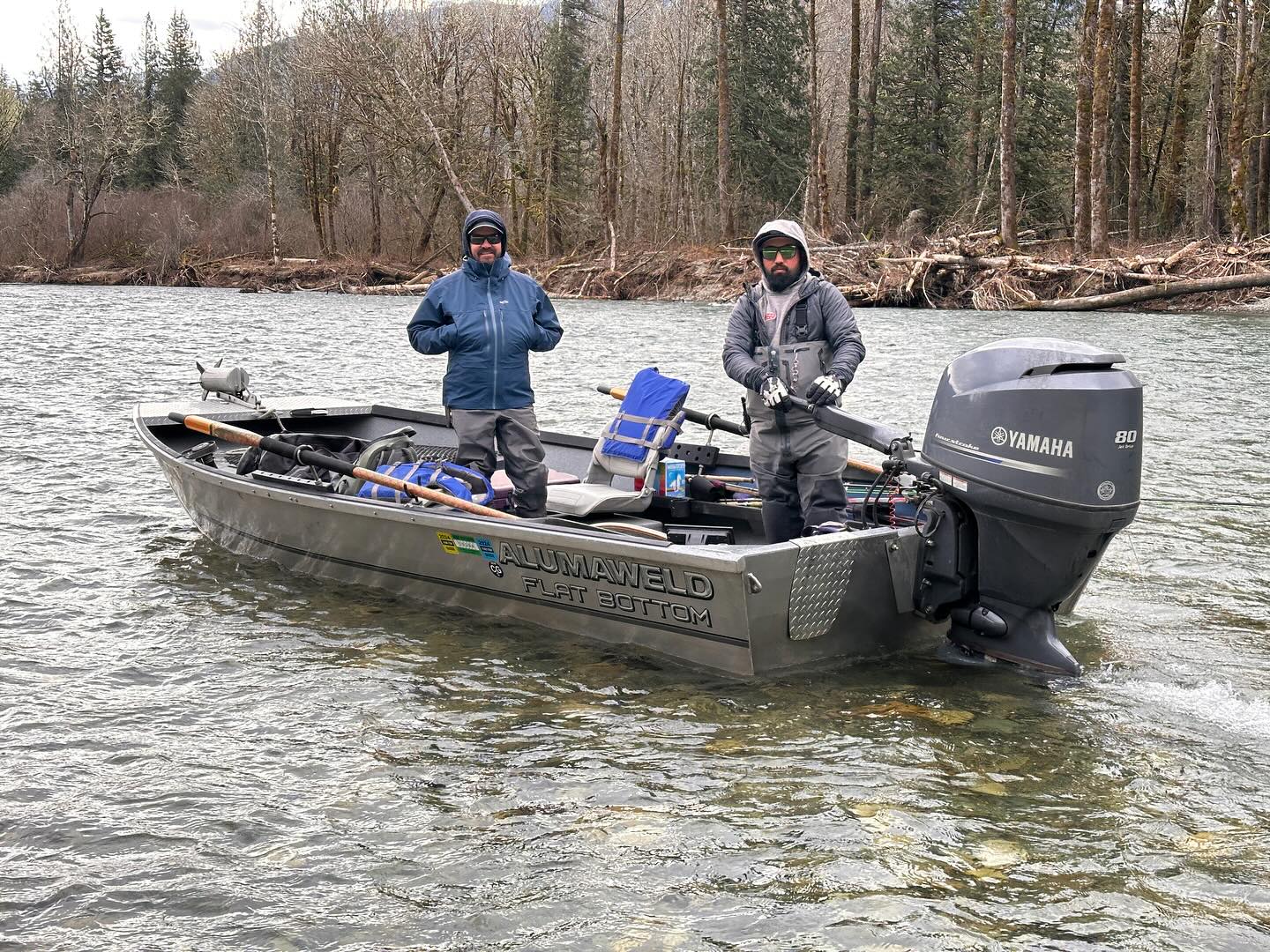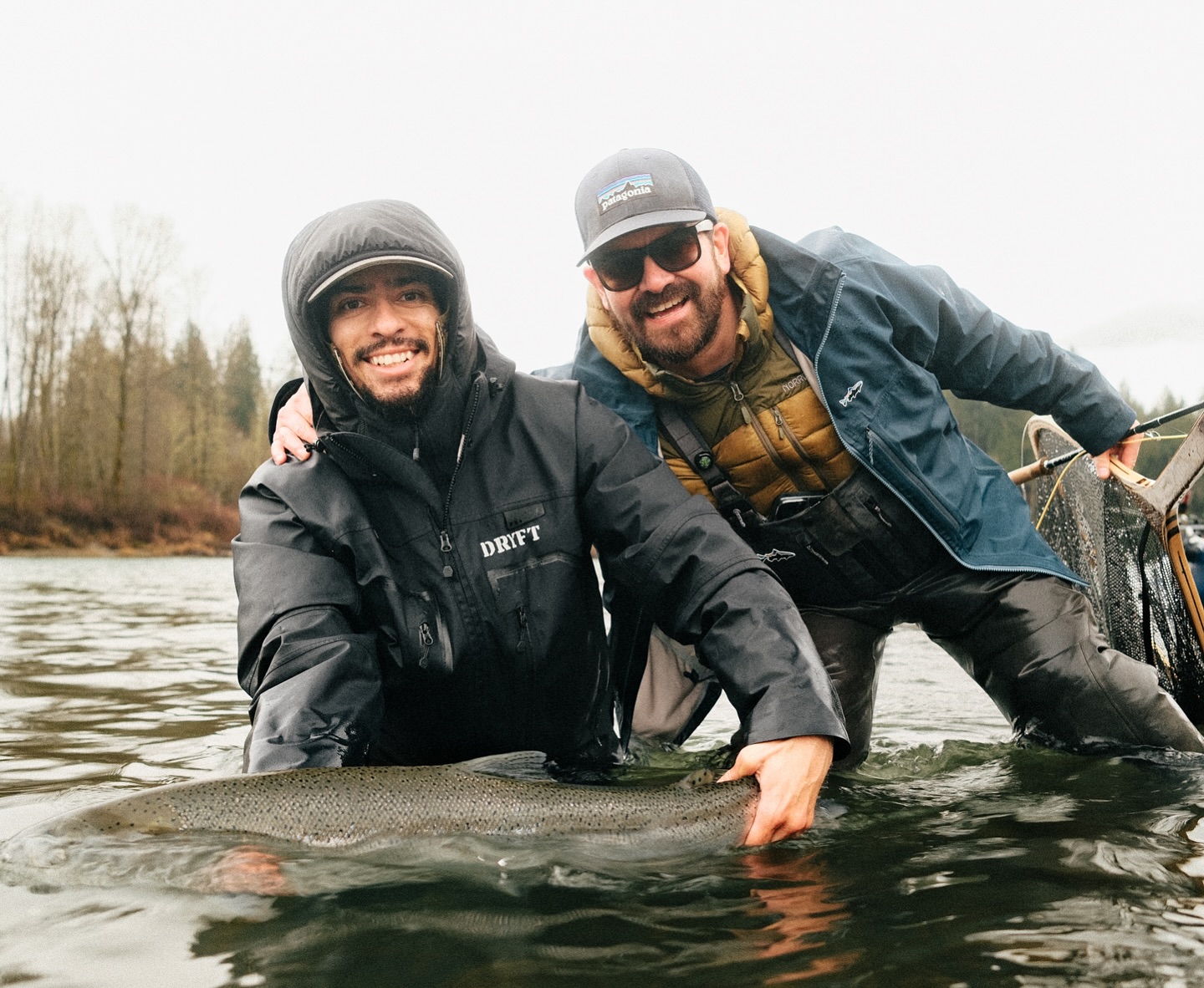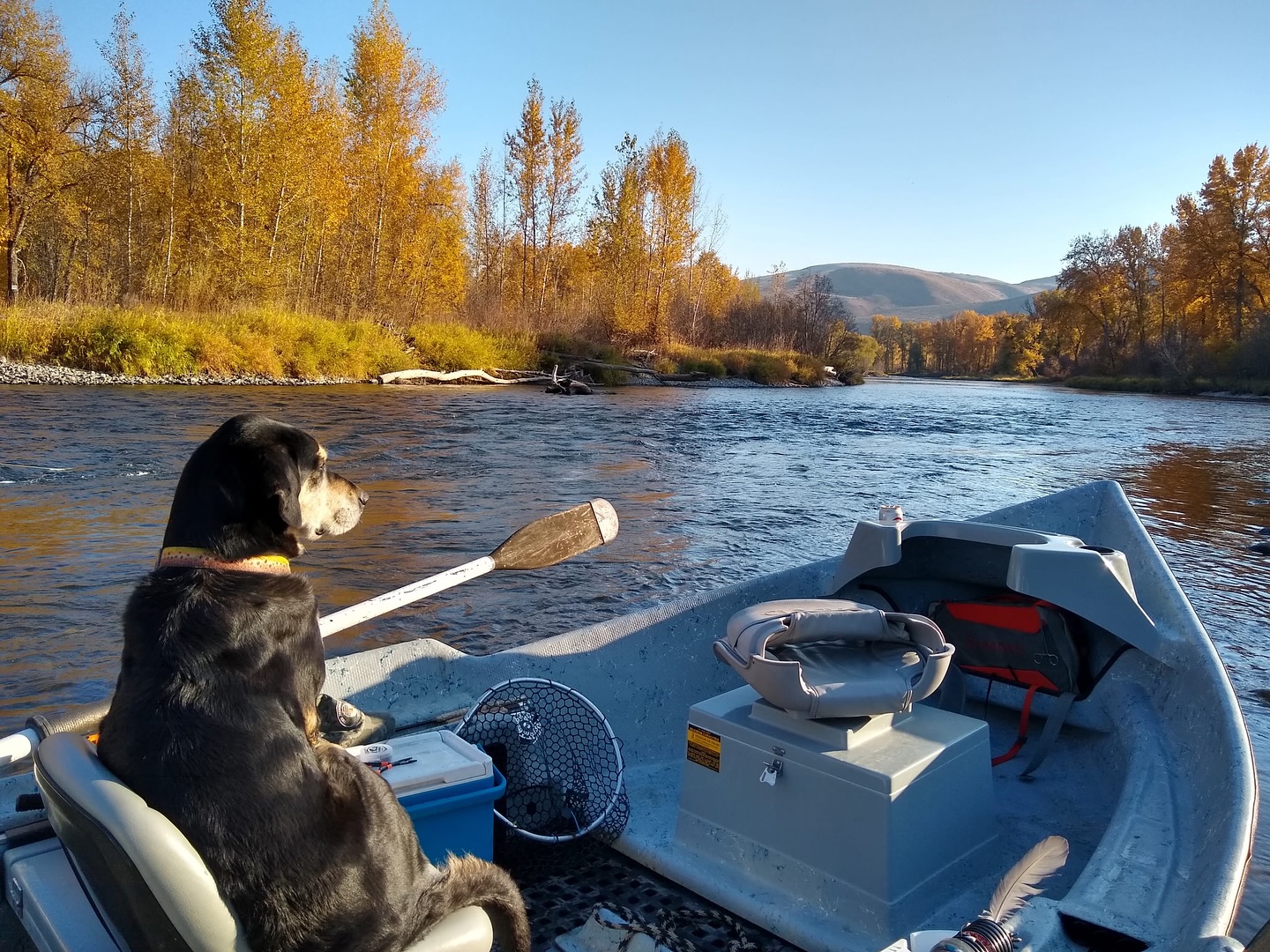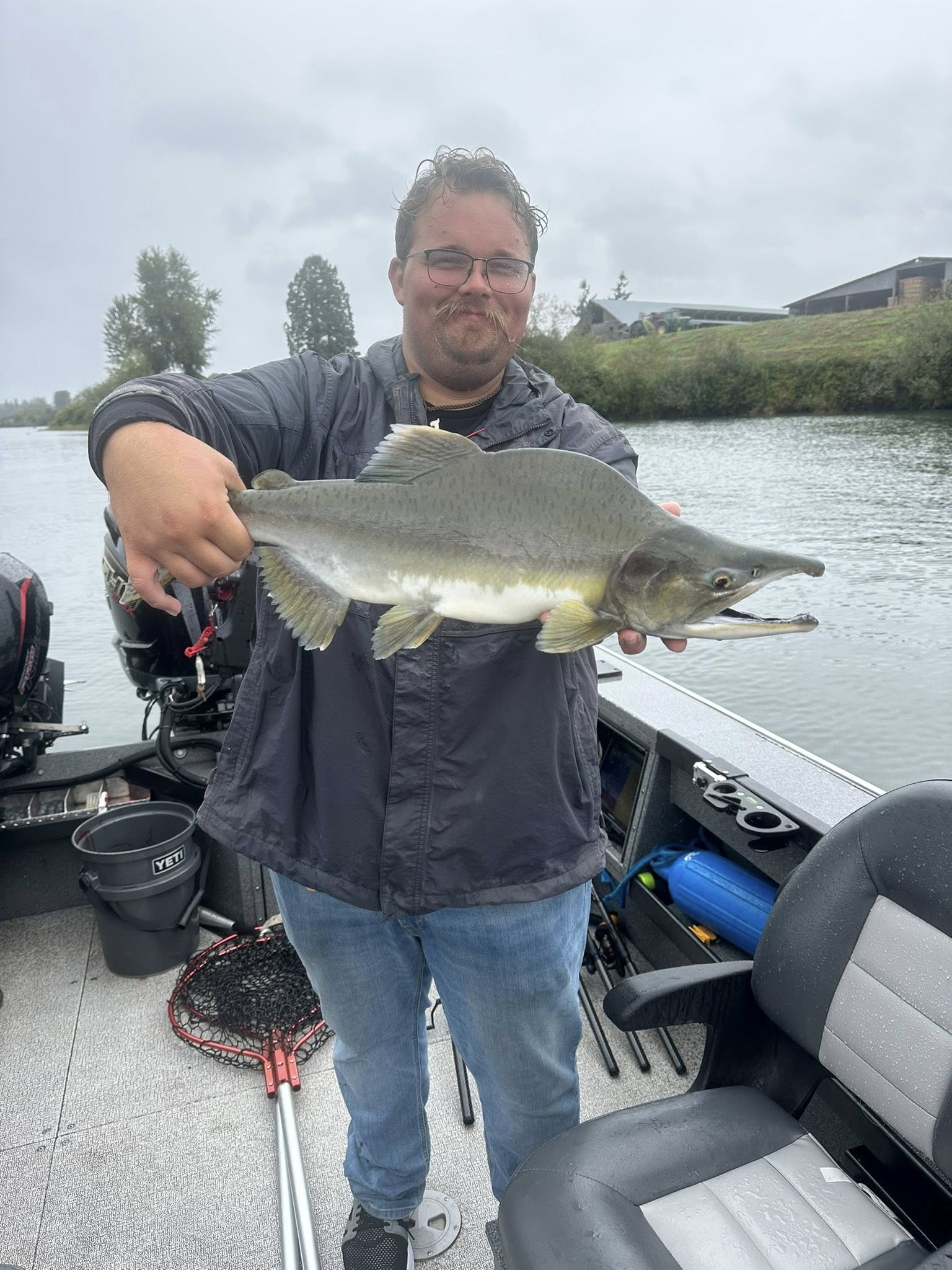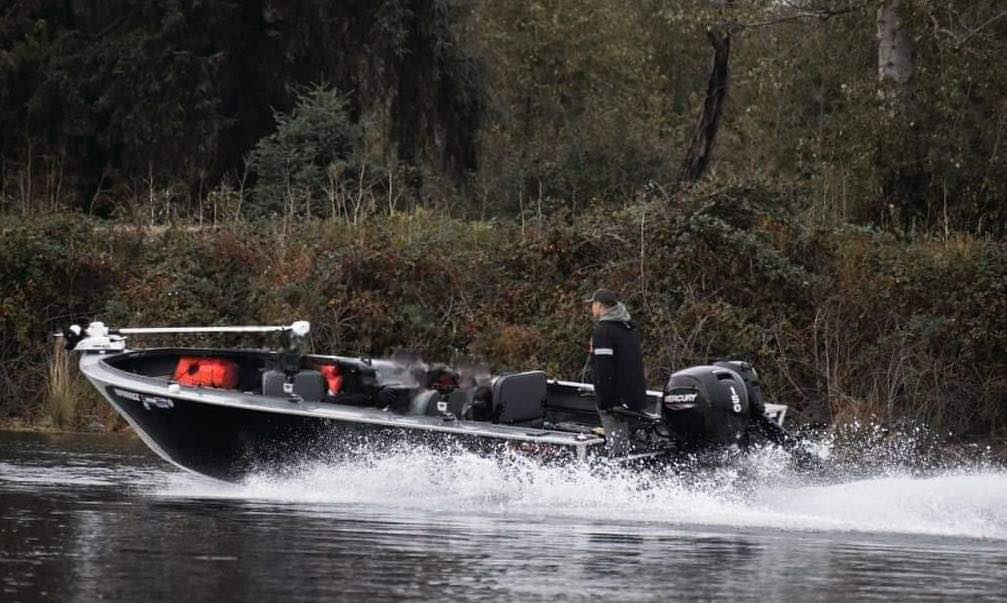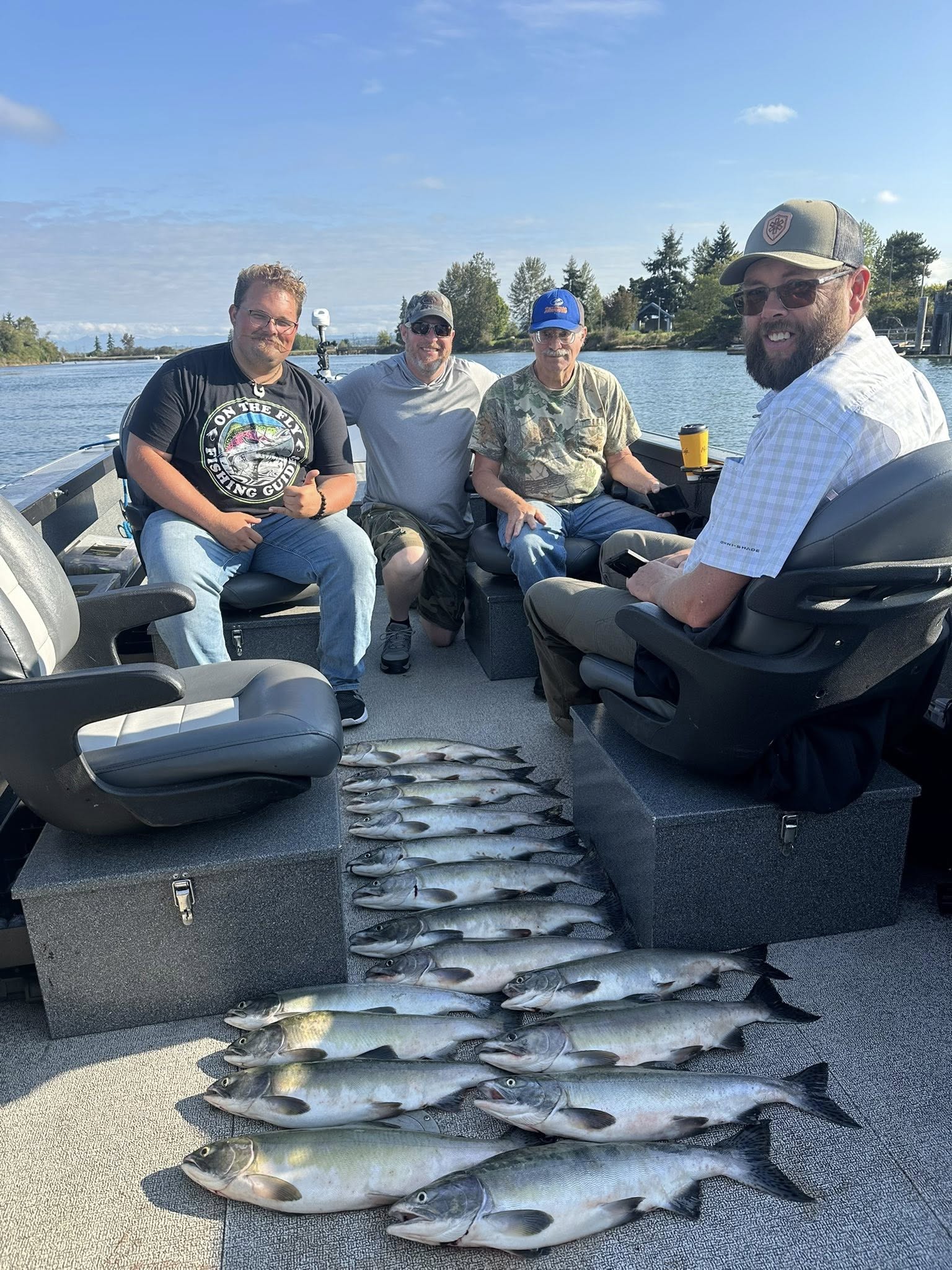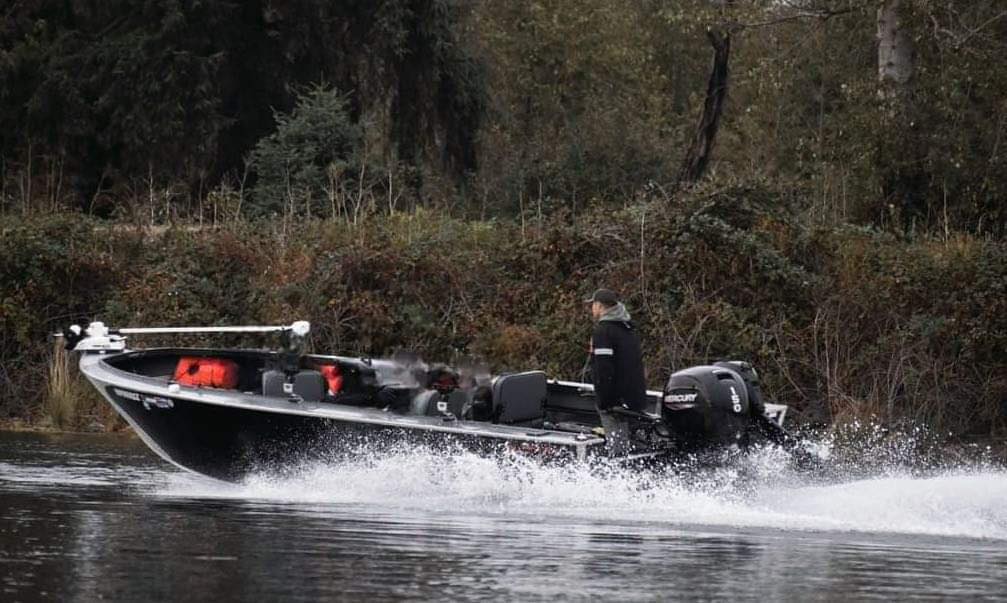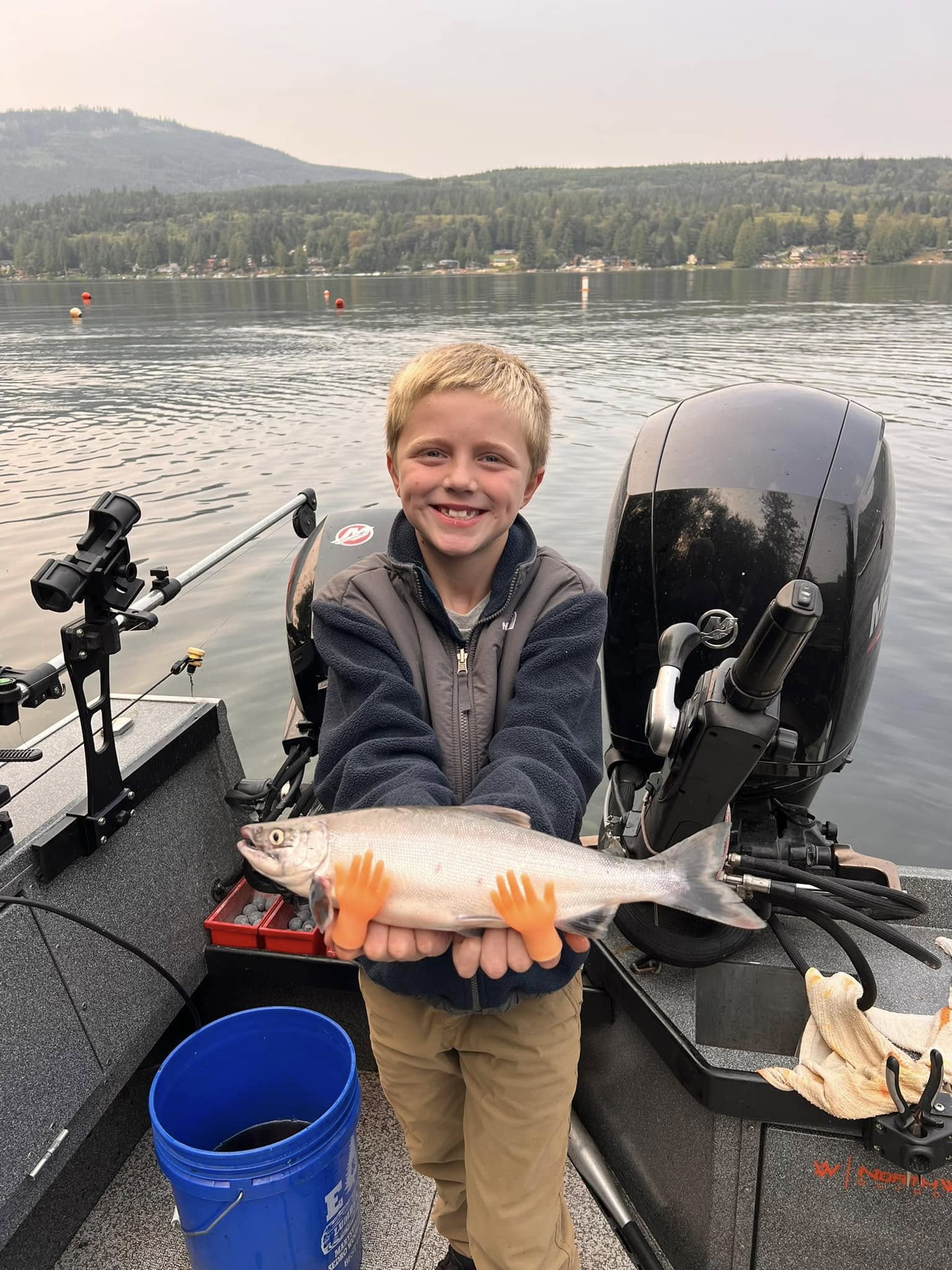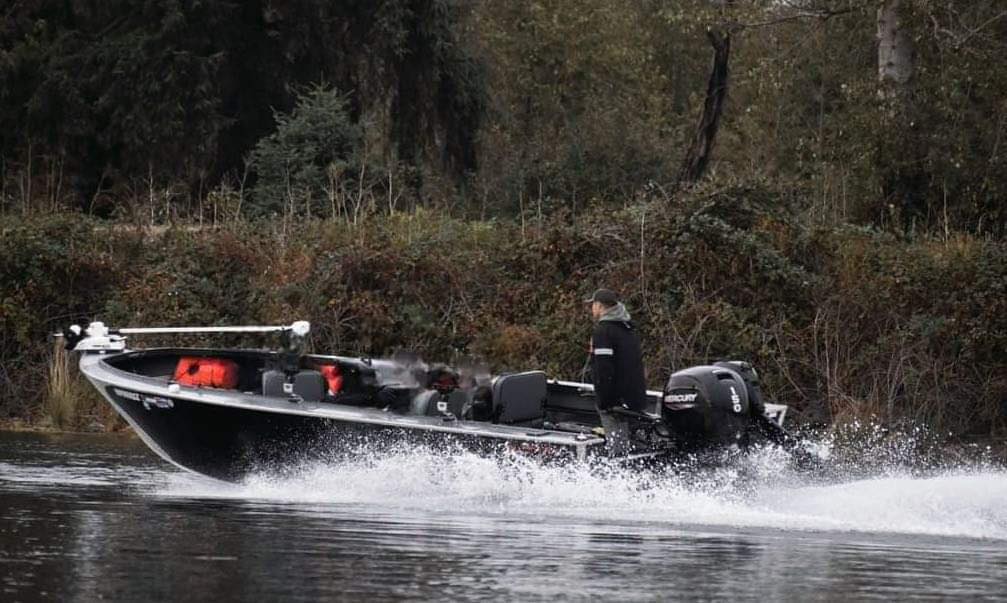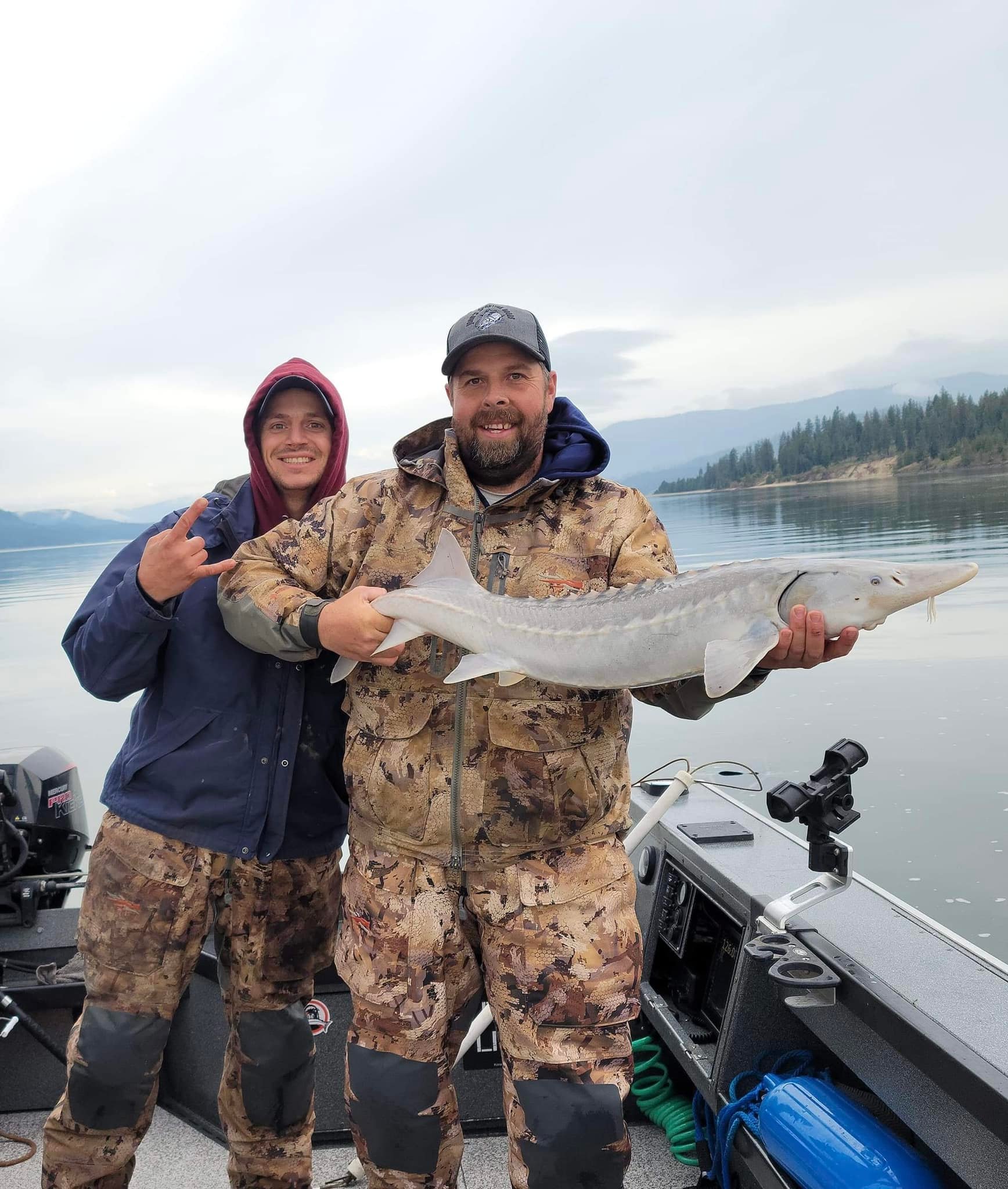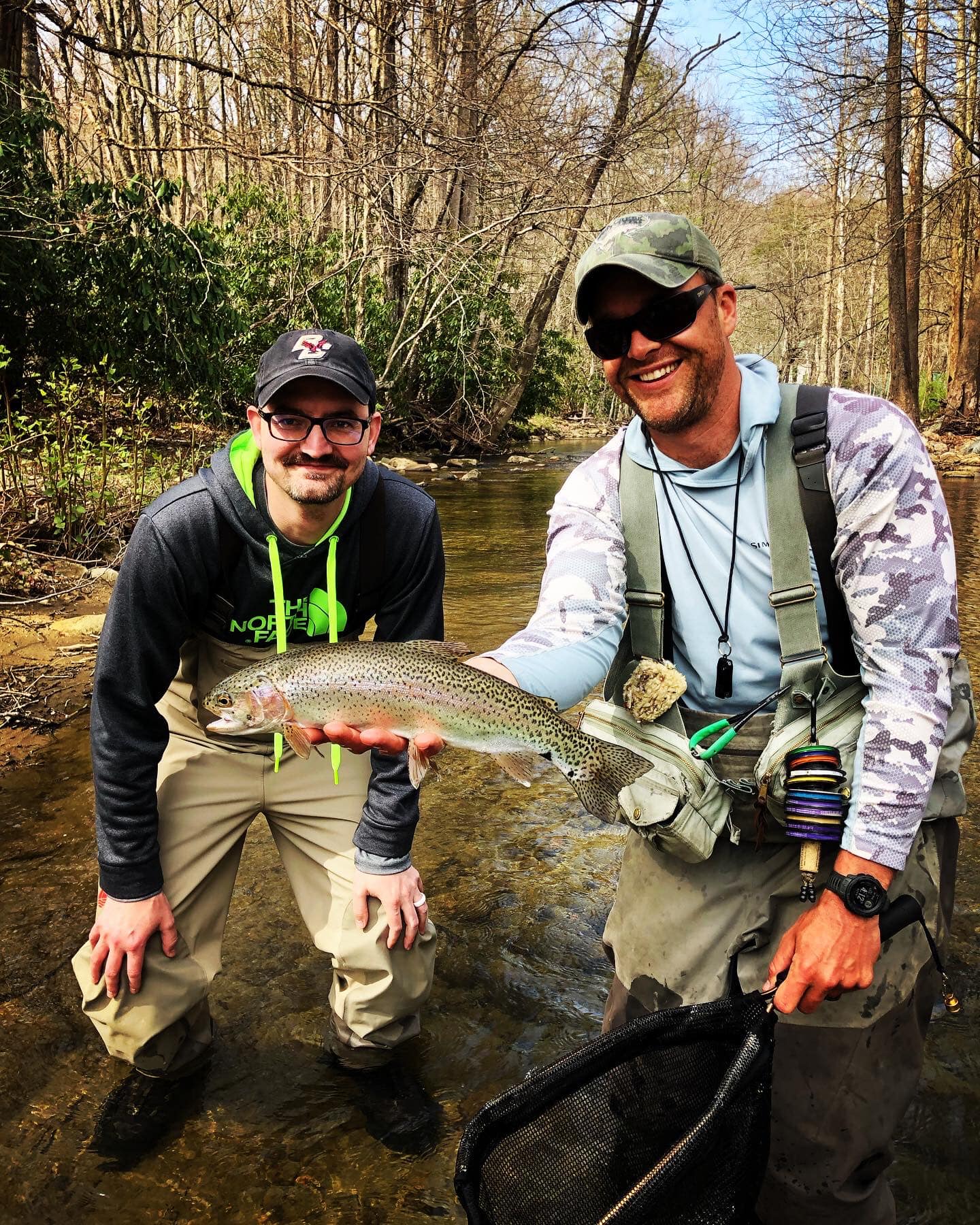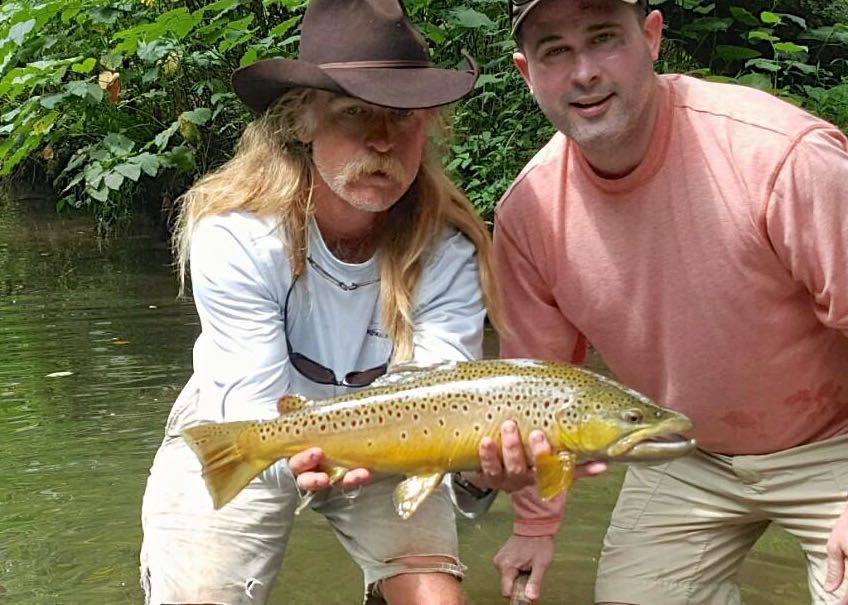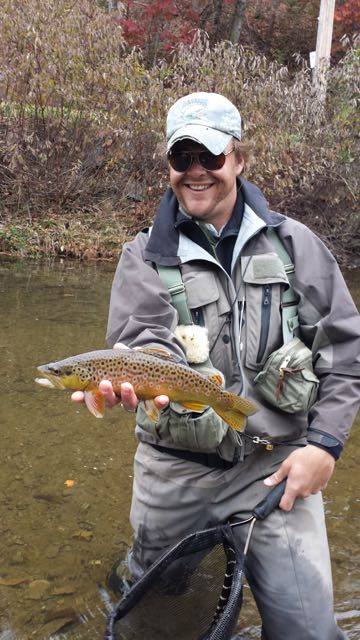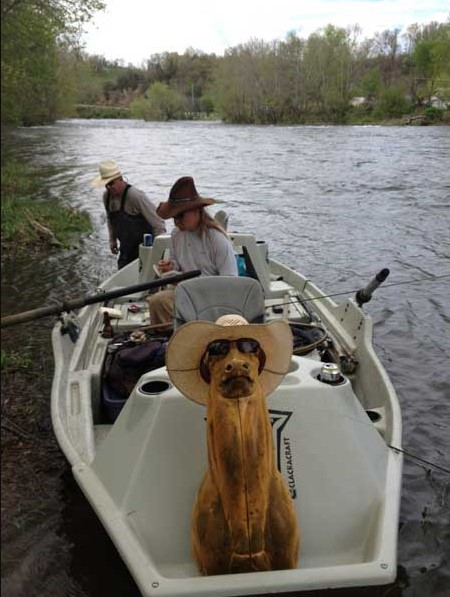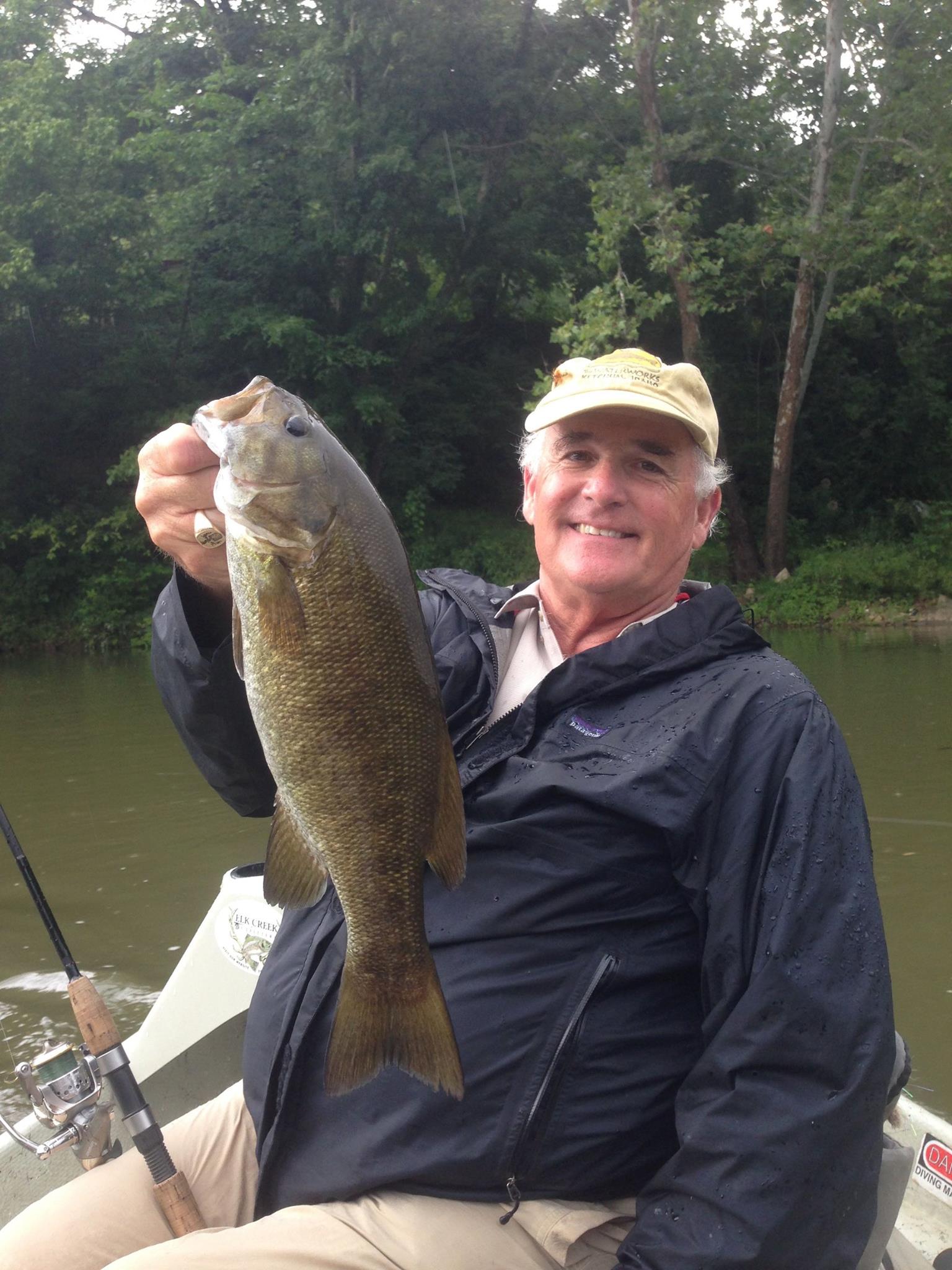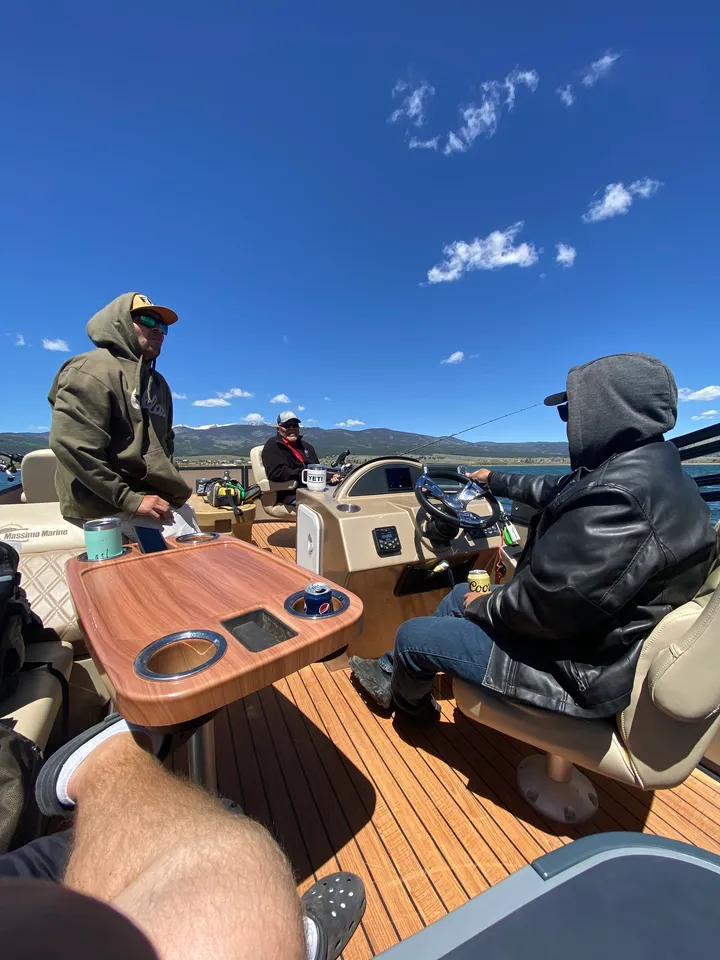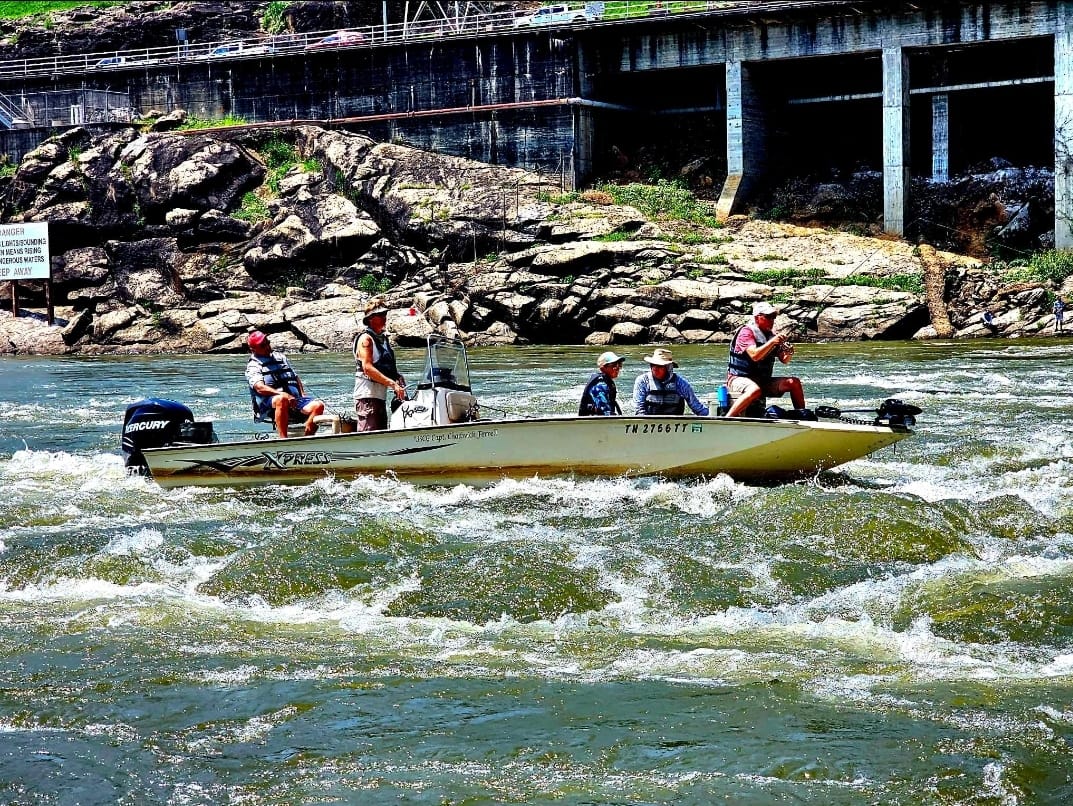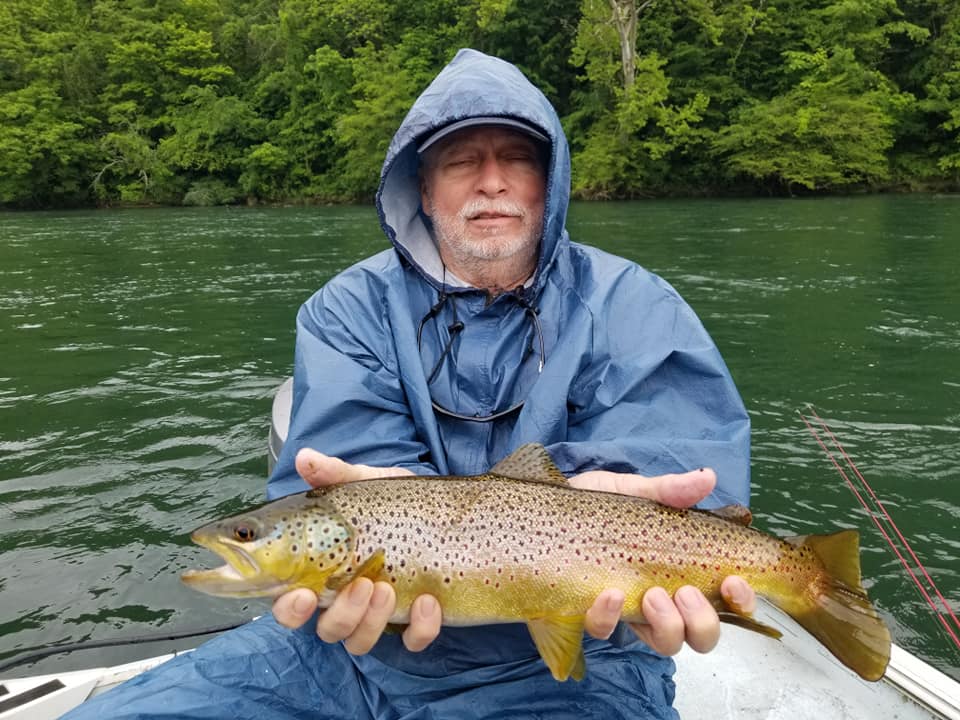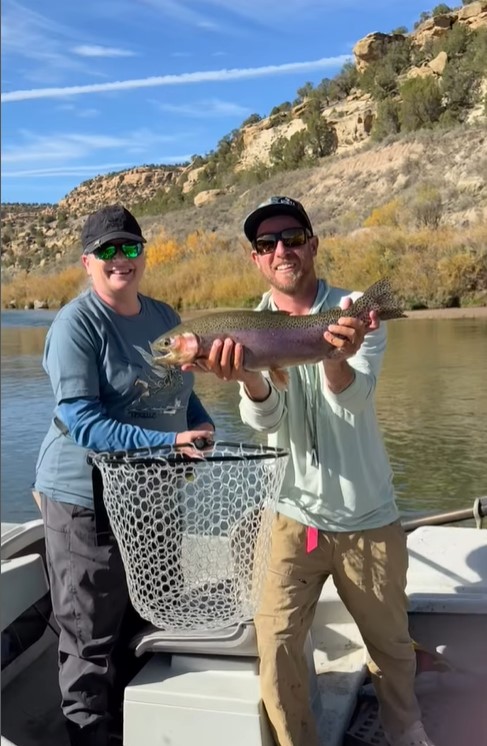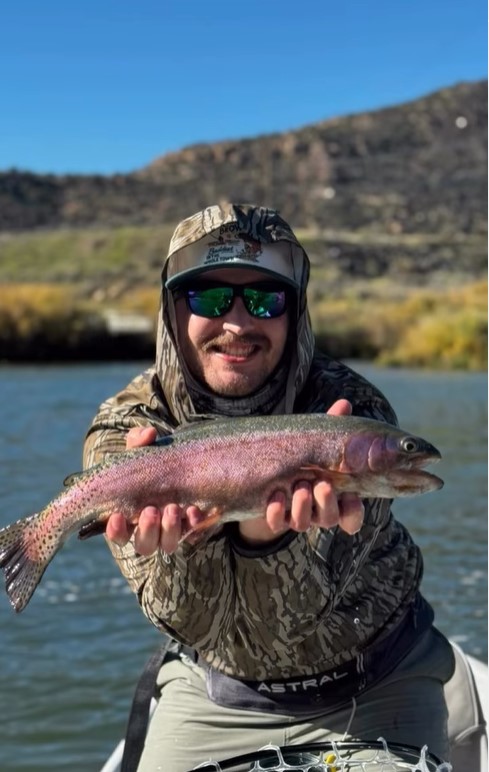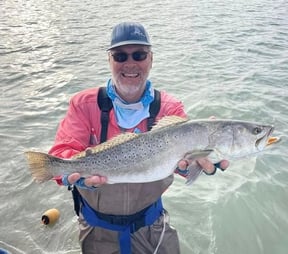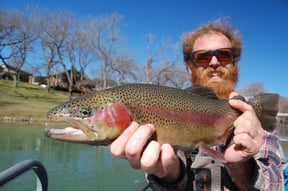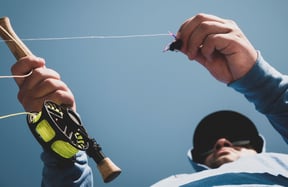Salmon And Steelhead Guided Trips
Olympic Peninsula Steelhead
Snohomish River Pink Salmon
8 Hour Trip – Winter Combo
8 Hour Trip – Fall Kings
Wade Fishing Trip
Float Fishing Trip
Full Day Pontoon Fishing Trip
Trout Trip
San Juan River Fly Fishing
We started Captain Experiences to make it easy to book fishing and hunting guides around the world. With over 2,000 Damn Good Guides, our platform makes finding and booking a trip seamless. Head here to check out our trips.
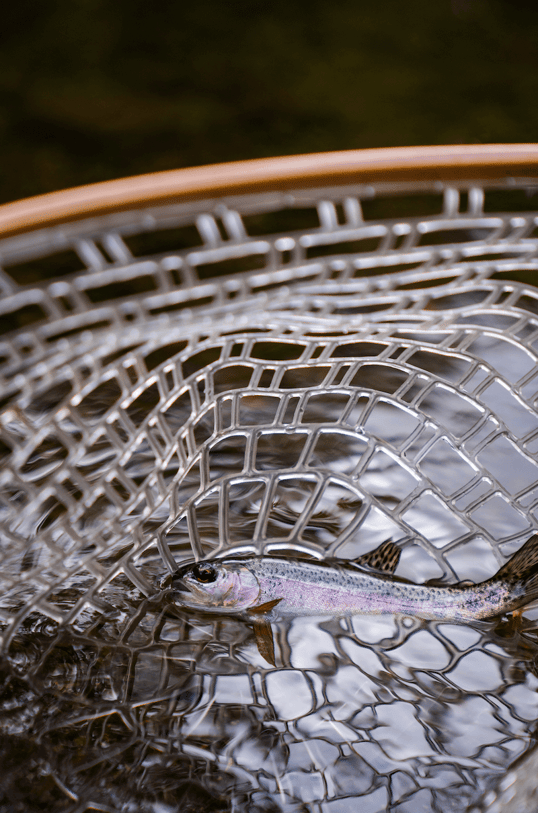
A Tanzanian rainbow in the net.
After thanking Jason and the crew, feasting on a delicious Indian dinner in Dar, and treating ourselves to a rowdy night in Dar at Crafty Dee’s (one of Doug’s favorite stops), we wake up and fly from Dar to Arusha hoping to uncover rare Kili trout. We are heading to be among the first people to catch self-sustaining rainbow trout in its foothills. German colonists released rainbow trout here over 100 years ago and left them to their own devices, and throughout the course of Tanzanian history no one has touched these streams. Fishing here has been banned for most of that time.
The fishing only opened up in 2021, and we are fortunate enough to have linked up with our guide Dom Lever, who is currently the only person who holds a fishing license for Kilimanjaro.
We take a quick hour flight from Dar es Salaam to Arusha and hop in the car to drive straight up to Kilimanjaro. We saw the legendary mountain from the air, but driving up to it is another sight entirely.
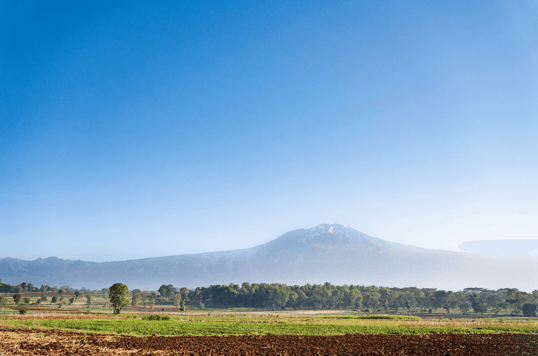
A view of the expansive Kilimanjaro. The mountain spreads for miles in every direction, and in between each of countless ridges are unique rivers and streams.
The mountain seemingly rises from nothing. It is an enormous, singular mass on otherwise flat terrain. Its snowcaps accentuate the almost comical difference between the top of the mountain and where we are standing at its base, in 80 degree weather.
We start the drive in terrain similar to much of the rest of Tanzania in the dry season: red dirt roads, dust devils in the surrounding fields, and trees that have gone barren for the dry season - everything is craving water.
As we begin to head uphill, the scenery dramatically shifts and the fauna on either side of the road flips a switch. We begin to pass fertile, green farms of potato and cabbage and other ground vegetables. We drive through big groves of banana trees. We start to see landscaping on the sides of the road and bright green hedges blocking the houses.
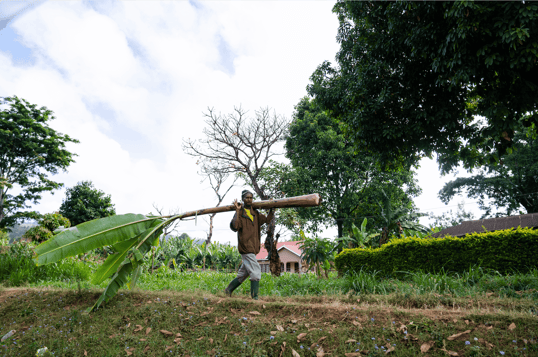
A local man relocating a banana tree.
We can tell it hasn’t rained based on the red dust collecting on the leaves of the banana trees, but the landscape remains lush nonetheless.
We drive up through the foothills to a point a few miles up, and we are now in the roots of the mountain. Kilimanjaro is such a large landmass, that its base shoots large hills and canyons extending in every direction. The terrain is extraordinarily hilly, and each canyon has its own people and culture.
We reach a small town perched on a hilltop, and drive down to the campsite (maintained by the local church) which is perfectly placed grass clearing right by the stream. Massive old growth trees sit all around and monkeys and giant hornbills perch above us in the branches.
Here we meet up with Dom’s friend Ake (“Just call me Orca” he says) who has set up our trout camp, and we get situated before lunch.
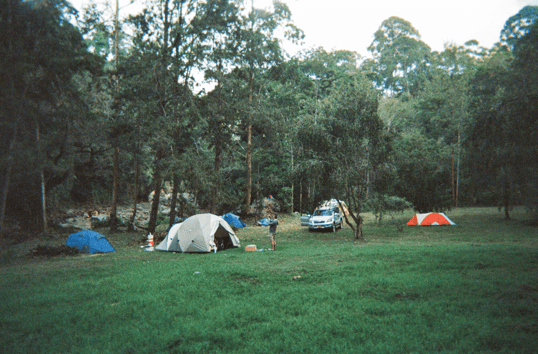
Our fly camp in the foothills of Kili.
Ake is a full-time backpacking / mountaineering guide on Kilimanjaro and the historic Rift Valley system, and is intimately familiar with the area. He has climbed Kili hundreds of times, and in between trips has spent his hours exploring these less traveled foothills of the mountain, often together with Dom.
There is a lot of “traffic” near the camp, but it’s all relative. Just a few 2-person motorbikes, a few locals carrying bundles of wood or crops on their heads up the big hill towards town, a few people washing their clothes in the river nearby, and a local goat herder passing through.
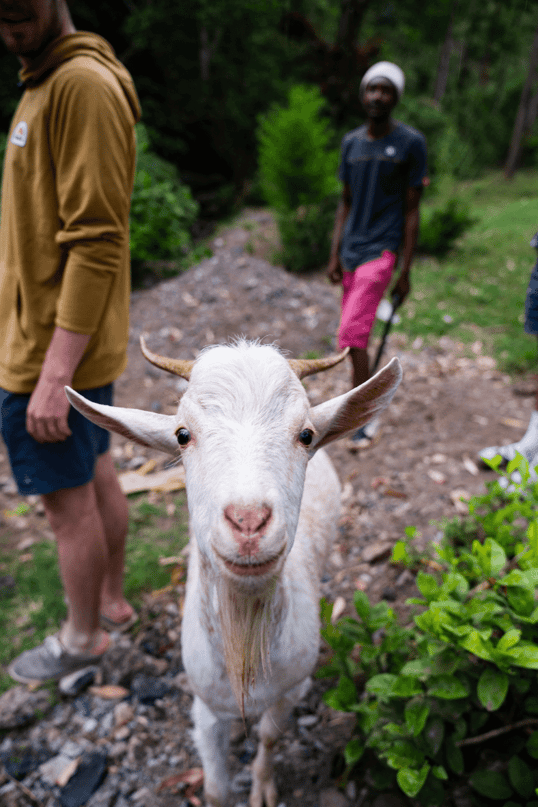
A local man Chief (in the background) letting his goats graze their way through our campground.
We quickly put away some gear and get ready for an exploratory hike up the mountain to our first stream in search of the long-lost rainbows.
The Art of Exploring a Virgin Fishery
We are searching for a fish that hasn’t been fished in 100 years, and this is no easy feat. There are no notes or maps or guidelines. The only reference points we have to go off are Dom and Ake’s memories from a few trips up the mountain within the last year, and some moderately reliable intel from a few locals who don’t speak english.
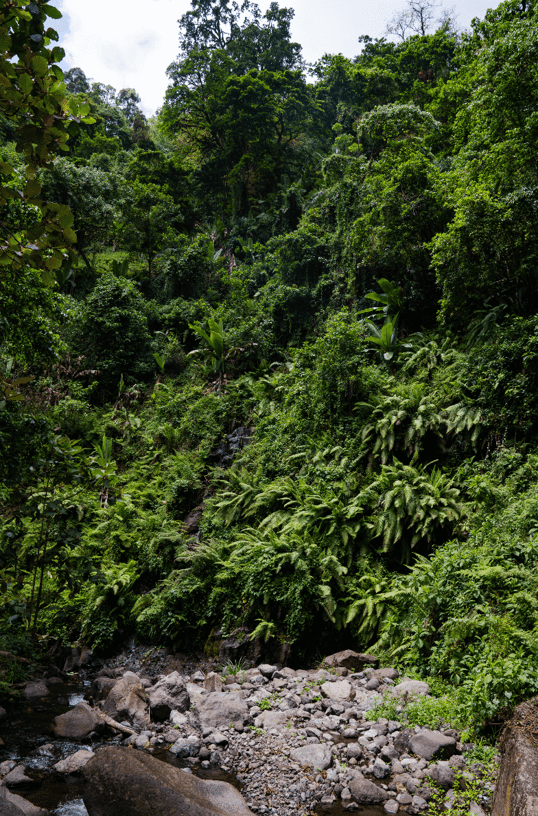
The walls of streams near Kili were often hundreds of vertical feet and filled with all kinds of ferns and other vegetation.
Exploring a virgin fishery is one of the most rewarding things an angler can do, and your prize is worth more than any personal best or new bucket list fish at home. You have not only done something new, but gone somewhere and done something no one has done before you. It is hard to explain that feeling, and hard to beat it as well.
But with this comes the challenge - miles and miles of hiking through unfamiliar terrain and thousands of casts in waters that may turn out to hold nothing.
We drive up the hill a few miles on a dirt road so plagued with potholes and rocks we might as well get out and walk - we are moving no faster than a snail’s pace.
At the top of this hill we sit on the divide between two rivers, one on either side of our ridge. We need to leave our car and continue from here on footpaths, and so we park with a local man, Max, at the top of the hill.
We meet our host Max and his 95 year old father (we called him Babu, but this just means grandfather). They wish us luck and we head down the opposite side of the hill to the river.
The hike down to the first river from here is steep and long. We probably descend 5-600 vertical feet like we are descending into a canyon, dropping 1.5 feet with every step. The side of the canyon we are on has the remnants of a massive landslide where we are walking from, and it is clear that we are walking on a newly created footpath.
On the walk down we get lapped by a 15 year old kid wearing flip flops while we are struggling to keep our footing in our lace-up boots. He is walking down to the river to get firewood, a daily task.
We learn from him that in 2019 it rained for so long and so hard that this entire canyon flooded and a massive wall of the canyon eroded right where we are standing. Our path is indeed new, and there is a gaping clearing for one entire side of the gully.
We make it down and explore along the river for a bit before setting up our rods. We know that fish have been caught here before by Ake and Dom, so we start heading along the river to scout for signs of fish. Jonathan and Ake head upriver and Austin and I head down.
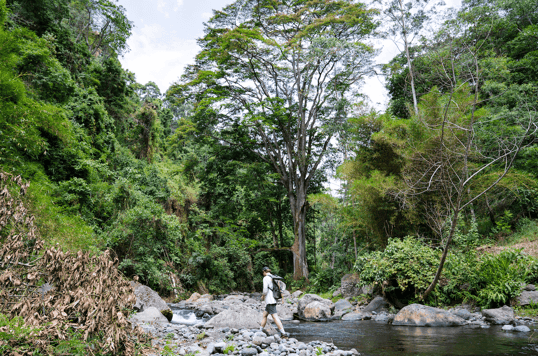
Finding fish involved boulder hopping up miles of river.
The river is more of a stream, and on either side we are dwarfed by the canyon walls, which themselves are covered completely by dense vegetation, including some giant old-growth trees and some of the biggest ferns we have ever seen. It feels like we are in a cool jungle (the temperature up in these hills is closer to 65 degrees, significantly cooler than a few miles down the road). The stream itself is studded with big boulders and we can easily leap from rock to rock to make our way downriver.
We don’t get any bites in this area and don’t even manage to see a fish, and we begin to be concerned by how warm the water is and how much iron we see leeching into the water around the edges in some of the stagnant pools. The canyon is beautiful, but it seems no fish are to be had here. We hope that the fish that have been here in the past survived the floods, and that they have moved upstream to cooler waters and to avoid the metals in the water.
We resolve to try a different stream tomorrow, and make the long trek back up to Max’s place.
The Culture of Kilimanjaro: The Chaga People
We get to Max’s and he invites us to the backyard for coffee, which he has made himself from beans in his backyard. We graciously accept, and head back to sit on the sort-cut grass among his garden while he prepares some hot water.
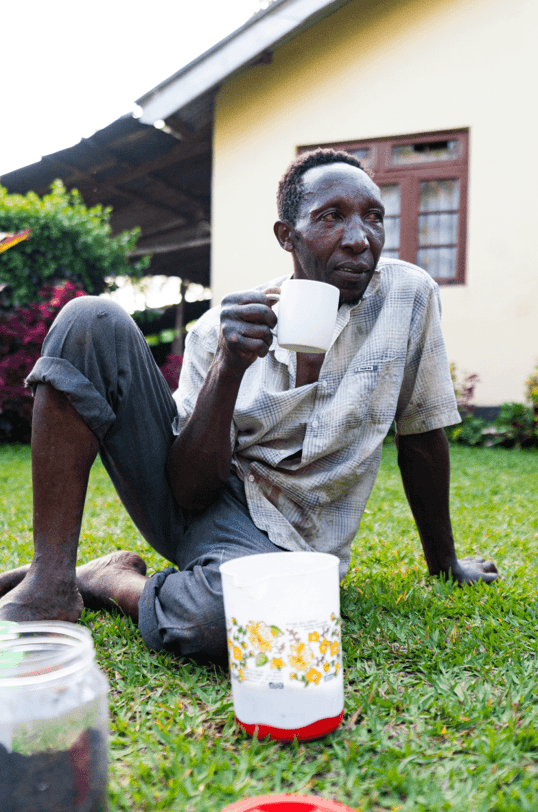
Our friend Max sharing homegrown coffee with us in his backyard.
The coffee was delicious, and with the help of Ake’s translation we learn a bit about Max’s life and the people in this area.
As the youngest son of his parents, Max is the one who stays home to help his aging parents and the homestead, while his siblings have long-since left home for bigger cities to find work and send money back to support them.
Max takes us on a tour of his property so we can see his farm, and it is clear he is entirely self-sustaining here, growing yams, bananas, coffee, beans, potatoes, and avocado, as well as raising pigs. Water is brought down through an old communal irrigation system from far up on Kili, meaning they don’t need to hike miles down the canyon to the river for water or irrigation.
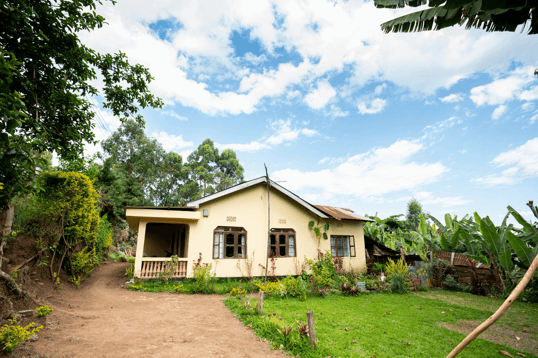
Max's house in the foothills of Kili.
We ask Max if he had any questions for us and he says no, he is just happy we are there with him getting to learn and enjoy each other’s company.
Max is about 60 years old but looks no older than 35 or 40, and this seems to be a trend among people in this area. Babu is 96 but looks about 70 years old. We later learn that this is mainly due to their diet, and that many American and European dieticians come live here to try to learn about this healthy subsistence lifestyle of the Chaga tribe.
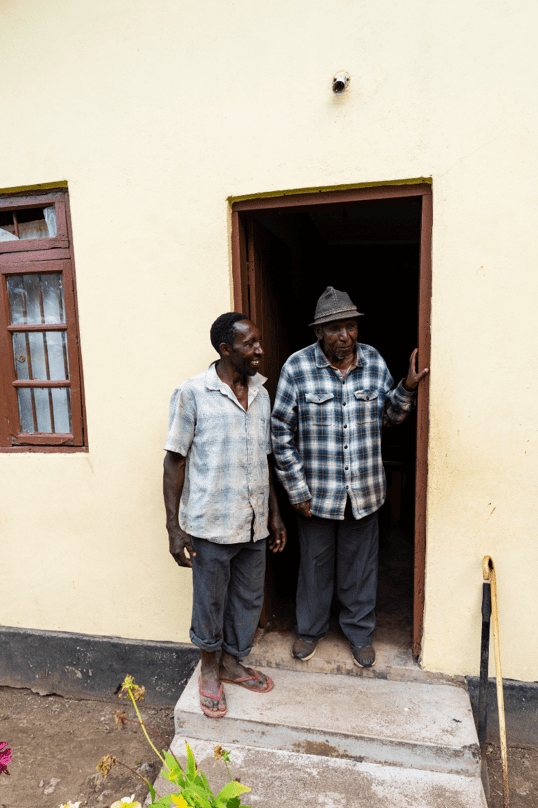
Max and his father, "Babu."
Max is a member of the Chaga tribe, which is one of the most well known in all of Tanzania for their business acumen. While the people all over Tanzania have been friendly, the Chaga have been by far the most outgoing. This is their homeland in the foothills of Kilimanjaro, but many Chaga (like Max’s siblings and children) have left home to start and run businesses in other parts of the country. Access to education is widespread and valued.
The homes here are large, consist of a few rooms, have landscaping and large hedges on the periphery of properties, and homes are made of solid materials. The people have ready access to food and water, and the communal buildings (generally churches or mosques) are ornate. Overall it is clear that money is spent on family and togetherness.
Having learned much about his culture, grateful for the hospitality, and energized by Max’s coffee, we say goodbye to Max and Babu and head down the mountain in the dark, nearly getting lost and struggling to find our campsite.
Finding a Population That Was Forgotten for 100 Years
Ake wakes up before sunrise to scout our second river while the rest of us eat, get gear ready for the day, and head to scout a third River. The scouting report from Ake comes back successful - fish found!
Ake returns and heads back to Arusha for his nephew’s birthday while we follow his footsteps up the second river from earlier. This river is the canyon over from the first river where we fished yesterday. We hike about a mile upriver, hopping across half-submerged boulders without any sightings at the beginning of the day. The river does look much cleaner and colder than the river from yesterday.
We eventually reach a dead-end in the form of an incredible 50 foot tall waterfall. The canyon walls close in and it feels like we are in a 100 ft tall half-dome. The waterfall spouts out the middle and the rocky walls are covered in moss and ferns. The water congregates in a moderately deep 60 foot in diameter pool.
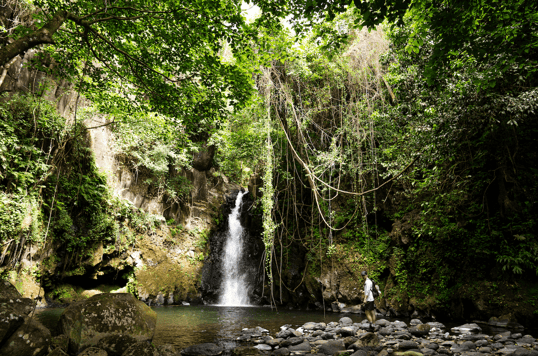
We stumbled upon this waterfall that in another country might be overrun with tourists. Here, we got to fish and enjoy a nice swim in the cold water.
We cast around with fly and conventional to not much luck (one bite), but it is encouraging that we have seen a sign of fish, and we know they are still here.
After an hour of casting we decide a nice shower is in order, and we swim under the waterfall for a few minutes in the freezing water.
We hike back downriver around lunch time and pack the car to head to the third river to try our luck there.
We get to a bridge across the river and eat a packed lunch of chicken and vegetable chapati (somewhere in between a tortilla and a pita). We share some lollipops with the local boys who are swimming nearby and head upriver.
We make our way and stop everywhere we think is fishy enough. The water is ice cold and the stream is flowing, with plenty of boulders and deep pockets and rapids. The canopy overhead is also impressive, with tons of birds and tall trees and rock walls extending high overhead.
We head farther and farther upriver and try a number of small dry flies and nymphs (plus some rooster tails and small gold spoons) to no avail. We don’t even see fish.
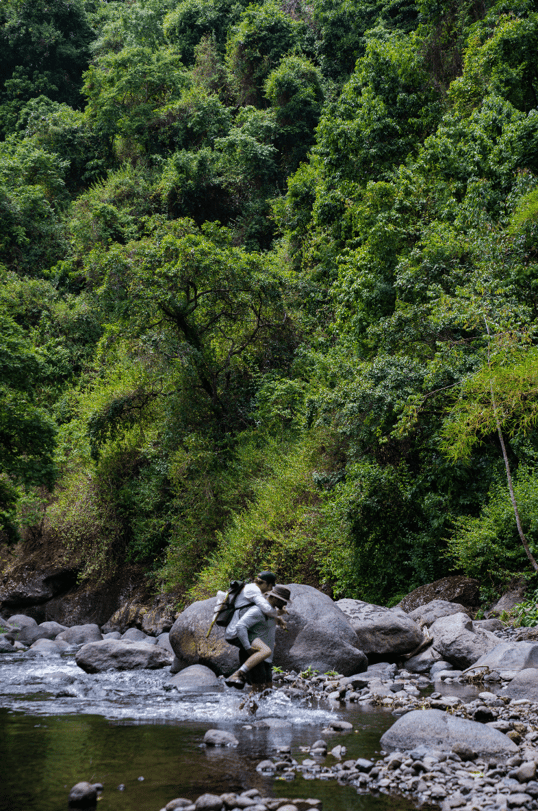
Jonathan helping Attison across the river. Water shoes are a must.
We head down river and, aside from a few leeches, we make it back without catching anything. We are feeling a bit dejected by this point. We have one day of fishing left and have yet to even really see a fish, aside from one quick bite. We do feel we have been getting closer to fish every minute though, and we are honing our radar for the fish.
We get back to camp and quickly remake the fire (the temperature here drops pretty significantly at night. It can be 80 in the day but 50 in the middle of the night). We enjoy a few beers and collect some firewood for later and gameplan for the following day. There are rivers in every valley around Kilimanjaro so we have endless (and to our knowledge, totally unexplored) options, but we decide that our best bet is to double down on the second river where we had a bite and try to circumvent the waterfall to head further upriver.
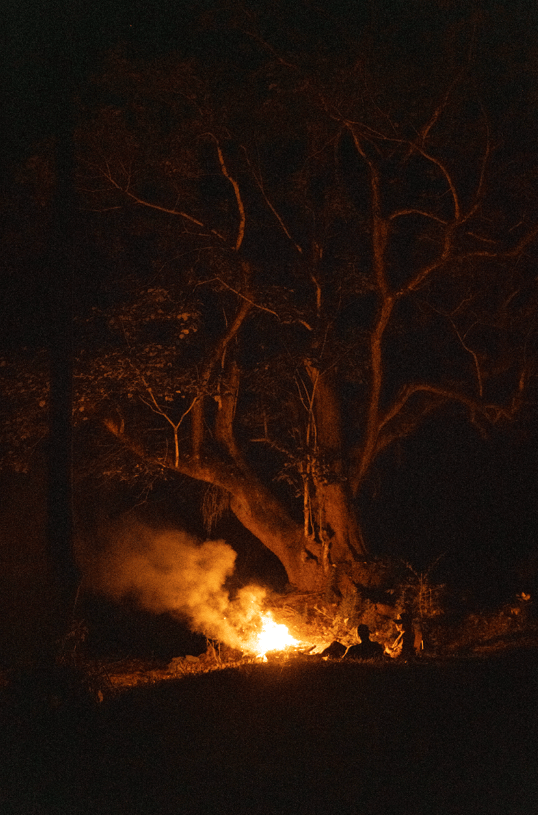
Gameplanning for the following day by the campfire at our fly camp.
We wake up early and head upriver to untested waters. We have to do a bit of driving on sketchy roads to find out how to get above the waterfall, and after some driving around we head about as far upriver as we can get, figuring the fish to prefer colder waters further up the mountain.
Our goal is to hike as far upriver as we can to the Kilimanjaro park boundary (no one is allowed to fish in the actual park, Dom’s license only extends to the boundary).
We start hiking upstream, sometimes walking across stones and sometimes walking on small footpaths made by locals along the river.
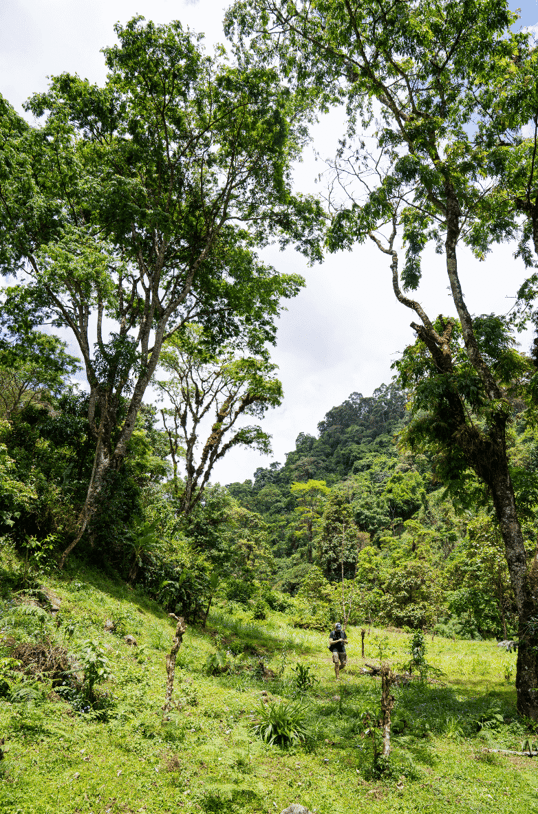
Hiking upriver to find the trout.
We walk past pools and cast into each, and the further up we go the more good signs we see. We find incredible, cold pools with nice rock cover and deep pockets.
After a mile or two, we spot our first fish, 3 small trout ranging from 4 inches to 6 inches. We aren’t being as cautious as we should after 3 days of hiking around trying to find fish, and they quickly scurry away into the rapids at the top of their pool. We cast to them but they are thoroughly spooked.
We are elated to have found the fish and progress upriver more slowly, with one person taking the lead spot and casting as we pass each bend in the stream.
Dom is up ahead of the rest of us and finds a perfect pool, with the rapids extending down into a 5 foot deep channel that widens to about 10 feet, with shallower water on each side. On one side of the channel sits a huge boulder, and Dom perches on the other side and casts over it, blocking any fish’s view of himself.
He casts his setup of an indicator and two nymphs, and watches as he sees fish come from under the safety of the boulder to inspect his fly, before swimming back. On the third cast he finally hooks one and brings it to the bank.
The rainbow is beautiful and small, the size of a normal Virginia brook trout, only about 4.5 inches long. He keeps the fish in the water until we can make it up with the net, and we net the small fish and remove the single, barbless hook before making a quick release and watching the fish head back under his boulder.
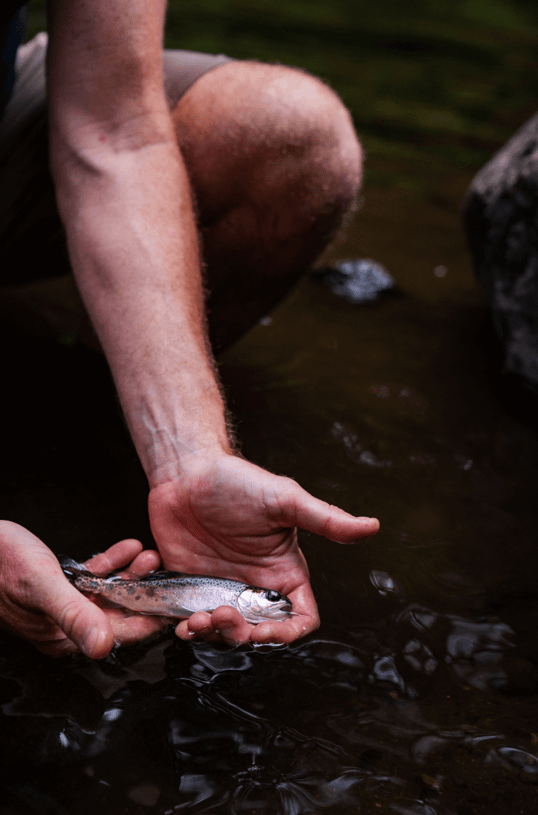
Our first (and fully-grown) Kili Rainbow.
We all celebrate this three day victory in the making, and reflect on what we have done.
This fish is the progeny of a line of rainbow trout that have not been stocked or touched in over 100 years. It has survived through heat and floods and predators it is not used to, from birds to mongoose to river otter.
On our end, we have found a fish that has been more or less lost to the angling community for 100 years. There is no documentation for which rivers were stocked 100 years ago and certainly no one knows where these fish exist today. This is exploratory fishing at its finest, and it feels all the greater to have successfully concluded our 72 hour search.
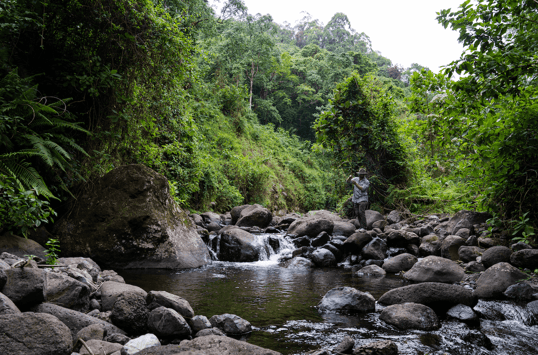
Jonathan hooked onto a rainbow.
We proceed upriver and land another 3 fish on the morning but have to turn back at noon to be able to catch our flight back stateside that evening. It’s tempting to keep hiking upriver, and we end up pushing the boundaries a little, finding ourselves trying out “just one more pool” and peeking around “just one more bend.” Eventually we are forced to hike back down and say goodbye to this beautiful river and leave further exploration to imagination.
We speculate on the fish and their behavior based on what little we have seen. We think the water is much warmer this time of year so the fish are much higher upriver, likely up in the park where we can’t fish, and that they will descend further down later in the season. We also speculate that there are some fish we just missed, or that weren’t interested in our presentation. These fish have grown skittish over the years, and given their tiny size are also easily overlooked.
We leave with the realization that there is no such thing as “hurry” in Tanzania. You need to be patient and enjoy the journey - the fish are just an excuse to get out and explore.
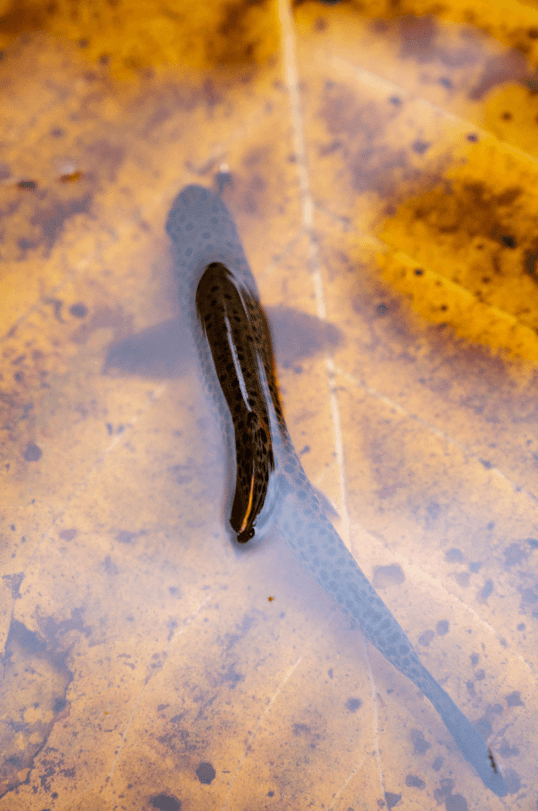
A rainbow swimming over fallen foliage - this population of rainbow trout has been unfished for over 100 years.
This is the fifth in a 5 part series:
Part 1: Habari, and Welcome to Tanzanian Fishing
Part 2: A Primer on Tigerfish Behavior
Part 3: Setting the Tigerfish Record
Part 4: 50 Miles to Latham Island
Attison Barnes
Updated on July 31, 2023

March 8, 2022
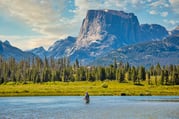
May 13, 2024
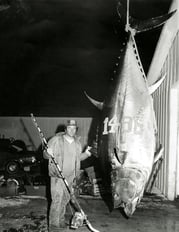
June 3, 2021

August 21, 2023

June 28, 2023
Related Articles
January 19, 2023
February 21, 2022
May 10, 2023
Featured Locations
- Fishing Charters Near Me
- Austin Fishing Guides
- Biloxi Fishing Charters
- Bradenton Fishing Charters
- Cabo San Lucas Fishing Charters
- Cancun Fishing Charters
- Cape Coral Fishing Charters
- Charleston Fishing Charters
- Clearwater Fishing Charters
- Corpus Christi Fishing Charters
- Crystal River Fishing Charters
- Dauphin Island Fishing Charters
- Daytona Beach Fishing Charters
- Destin Fishing Charters
- Fort Lauderdale Fishing Charters
- Fort Myers Fishing Charters
- Fort Walton Beach Fishing Charters
- Galveston Fishing Charters
- Gulf Shores Fishing Charters
- Hatteras Fishing Charters
- Hilton Head Fishing Charters
- Islamorada Fishing Charters
- Jacksonville Fishing Charters
- Jupiter Fishing Charters
- Key Largo Fishing Charters
- Key West Fishing Charters
- Kona Fishing Charters
- Lakeside Marblehead Fishing Charters
- Marathon Fishing Charters
- Marco Island Fishing Charters
- Miami Fishing Charters
- Montauk Fishing Charters
- Morehead City Fishing Charters
- Naples Fishing Charters
- New Orleans Fishing Charters
- New Smyrna Beach Fishing Charters
- Ocean City Fishing Charters
- Orange Beach Fishing Charters
- Panama City Beach Fishing Charters
- Pensacola Fishing Charters
- Pompano Beach Fishing Charters
- Port Aransas Fishing Charters
- Port Orange Fishing Charters
- Rockport Fishing Charters
- San Diego Fishing Charters
- San Juan Fishing Charters
- Sarasota Fishing Charters
- South Padre Island Fishing Charters
- St. Augustine Fishing Charters
- St. Petersburg Fishing Charters
- Tampa Fishing Charters
- Tarpon Springs Fishing Charters
- Venice Fishing Charters
- Virginia Beach Fishing Charters
- West Palm Beach Fishing Charters
- Wilmington Fishing Charters
- Wrightsville Beach Fishing Charters
